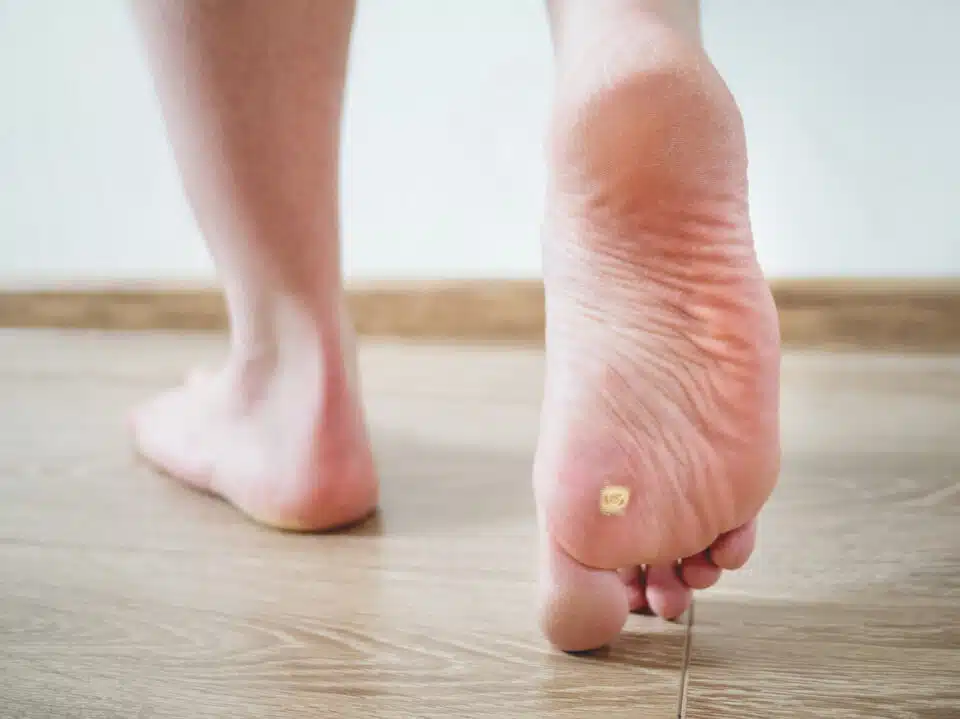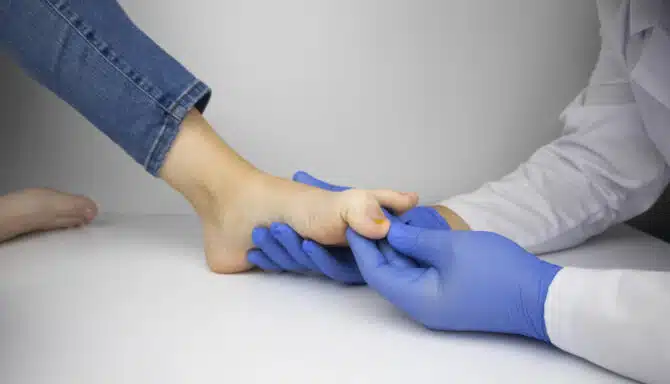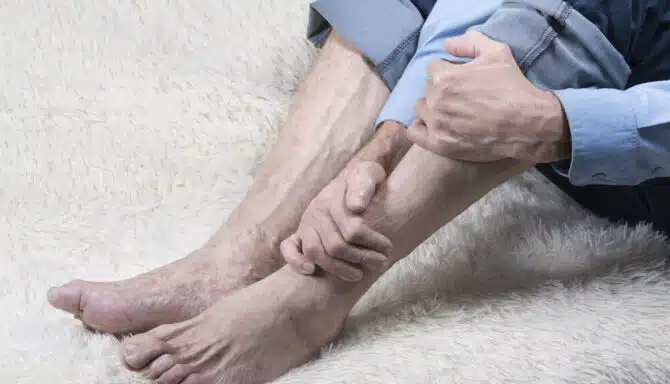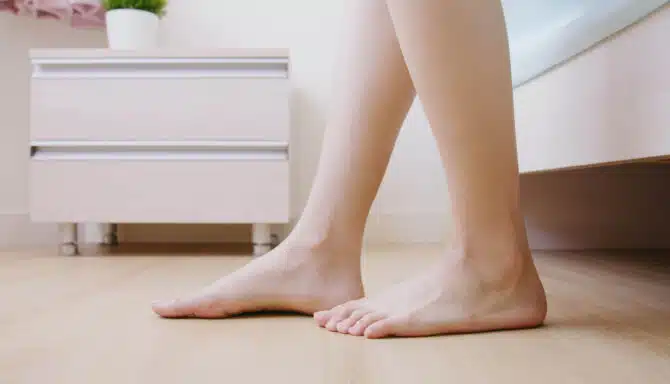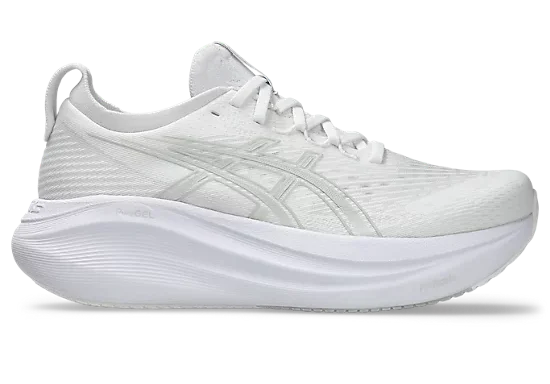If you’re wondering why your plantar warts keep returning, you’re not alone. But the good news is, you have options! Today’s article delves into the reasons behind recurrent plantar warts and effective prevention and treatment strategies. Keep reading to learn more!
What is a Plantar Wart?

A plantar wart is a non-cancerous skin growth that appears on the soles of the feet, caused by specific strains of the human papillomavirus (HPV), notably types 1, 2, 4, 60, and 63. The virus infiltrates the skin through tiny cuts or abrasions, often occurring in communal areas like public showers or swimming pools where the virus thrives. This is also the same type of communal environment that breeds athlete’s foot and fungal toenail, although those are fungal infections and not caused by HPV.
Once inside, HPV infects the basal layer of the epidermis, leading to the proliferation of keratinocytes and the formation of a wart. Due to the pressure from walking or standing, plantar warts often grow inward beneath a hard, thick layer of skin, which can cause discomfort or pain during weight-bearing activities.
Plantar warts are characterized by their rough, grainy appearance and may have small black dots on the surface, which are thrombosed capillaries. They can occur as solitary lesions or in clusters known as mosaic warts. The body’s immune response to the virus varies, and in some cases, the wart may persist for months or even years without treatment.
Plantar warts can sometimes look like other skin conditions, namely corns. Differentiating between them is essential, as their treatments differ. While both can appear as thickened skin on the foot, corns are caused by repeated friction or pressure, leading to a buildup of dead skin cells. Depending on the type, corns have a hard center and are surrounded by inflamed skin. In contrast, plantar warts are viral in origin. Additionally, warts may bleed when the surface is pared down, revealing pinpoint bleeding, whereas corns do not.

Plantar Warts: Risk Factors and Symptoms
In addition to walking barefoot in communal high-risk areas (i.e.: locker rooms, pool decks, etc.), there are other risk factors for plantar warts worth noting.
Risk Factors
- Weakened immune system: Individuals with compromised immunity, such as those with HIV or undergoing immunosuppressive therapy, are more prone to infections.
- History of plantar warts: Previous occurrences can indicate a higher likelihood of recurrence.
- Children and teenagers: Younger individuals are more susceptible due to their developing immune systems, and they may spend more time in communal areas like gyms, pools, and locker rooms.
- Excessive foot moisture: Constantly moist or sweaty feet can create an environment conducive to HPV infection.
Symptoms of Plantar Warts
- Rough, grainy growths: Small, rough lesions on the bottom of the foot, often on the heel or ball, that may interrupt normal skin lines.
- Black pinpoints: Tiny black dots, known as wart seeds, which are small, clotted blood vessels.
- Pain or tenderness: Discomfort when walking or standing, especially if the wart is located on a weight-bearing area.
- Callus formation: A thickened layer of skin may form over the wart as it grows inward due to pressure.
Why Do My Warts Keep Coming Back?
Plantar warts often recur because the HPV strain can persist beneath the skin even when visible warts seem like they’re fading away. This type of virus has developed mechanisms to evade the immune system, allowing it to remain undetected and cause warts to re-form later. That’s why it’s important to see your chiropodist one final time to verify that your warts are gone.
The immune system plays a crucial role in controlling HPV infections. Individuals with weakened immune responses or those on immunosuppressive therapies are more susceptible to recurrent warts . Additionally, certain HPV strains are more adept at evading immune detection, leading to higher rates of recurrence. Even in immunocompetent individuals, the virus can persist in a latent state and reactivate under certain conditions, which causes warts to come back.
Warts can also come back if you’re re-exposed to the virus. For instance, you can get warts again if your feet come into contact with a surface that came into contact with the virus before being disinfected (i.e.: shared showers, locker rooms, gymnasiums, pools, etc.). That’s why athletes and people who do barefoot sports (i.e.: swimming or gymnastics) are especially prone to wart reoccurrence. That’s why it’s important to disinfect footwear, along with high-risk surfaces with moisture buildup (i.e.: tubs and showers) with a 99% disinfectant solution that kills virus. This will kill any residual virus remaining in your belongings and residence and reduce the likelihood of re-exposure.
How to Stop Warts from Coming Back?
Preventative plantar warts care – both before and after contracting plantar warts – can help you avoid persistent foot warts. Remember, successfully treating warts doesn’t make you immune to them in the future:
- It’s important to keep your feet clean and dry, especially after showers or swimming.
- Always wear shower shoes or any suitable protective footwear in communal areas like pools and locker rooms.
- Don’t share shoes or socks, and avoid touching or picking at existing warts to reduce the chance of spreading the virus.
- Regularly disinfect home surfaces like bathroom floors and tubs if someone in the household has a wart.
- Moisturizing cracked heels can also help create a stronger skin barrier.
- After your last wart treatment, disinfect any footwear worn while you had the infection with a 99% disinfectant spray that kills viruses (i.e.: Lysol disinfectant spray).
These simple habits can go a long way in preventing warts recurrence.
What to do if my Warts Come Back?
If your plantar warts won’t go away on their own, wart removal treatment at a foot clinic from a chiropodist or podiatrist should be your next step. Here are some ways foot care professionals remove plantar warts:
- Prescription Topical Solutions (Salicylic Acid): This medicated treatment involves applying a high-strength salicylic acid compound directly to the wart over time. It works by gradually breaking down layers of the skin until the wart tissue is removed. Fun fact: salicylic acid can also be used to treat acne!
- Cryotherapy: This method uses liquid nitrogen to freeze the wart, causing it to blister and eventually fall away. The extreme cold damages the wart tissue and triggers the body to shed it during the healing process.
- Cantharone/Cantharone Plus: A potent topical solution is painted onto the wart to create a blister between the wart and the healthy skin beneath it. This separation allows the wart to be lifted away once the blister dries out and peels off. It may cause more discomfort than other treatments but results may be faster.
- Needing: A sterilized needle is used to puncture the wart multiple times after numbing the area. This process helps stimulate your immune system to recognize and fight off the virus that caused the wart.
- Excision: In this procedure, the wart is surgically removed under local anesthesia. It’s typically used when other treatments haven’t worked and involves cutting the wart out and sealing the area to reduce the chance of it returning.
Remember that enjoying other routine foot clinic services can be a great preventative step in keeping your feet clean and healthy, and warts at bay. Even a service like callus removal, a medical pedicure or simply your first initial foot assessment can be helpful if your chiropodist or podiatrist spots a plantar wart during the process!
